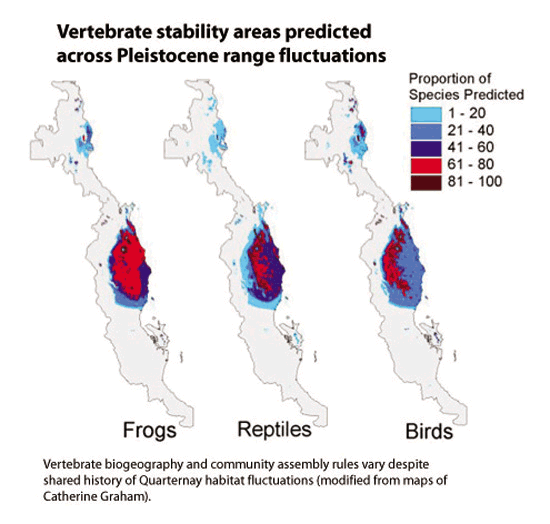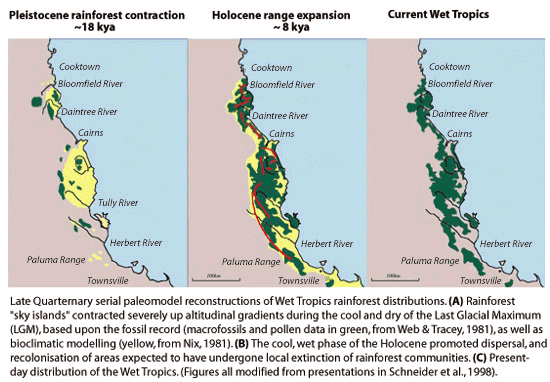 |
Australian
Wet Tropics
The Australian Wet Tropics (AWT) World Heritage Area is notable
for its high diversity and local endemism, harboring 75 regionally-endemic
and rainforest-restricted species of vertebrate of which 13
(six microhylid frogs and seven lizards) are restricted to
single upland subregions (ref). The rainforests of the AWT
occur across a stable geological setting and are thought to
be ancient and relictual, representing a rainforest biota
that was widespread on the Australian continent in the early
Miocene (Adam 1992; Morley 2000; Greenwood & Christophel
in press). Seated within the northern stretches of a larger,
fragmented coastal “mesotherm archipelago” (Nix
1991; 1993), east of the Great Dividing Range, the AWT is
the largest surviving tract of Gondwanan rainforest (<1Mha).
With the exception of microhylid frogs (Cophixalus), molecular
phylogenies indicate very little speciation in situ (most
sister taxa of AWT species are in rainforests elsewhere) and
levels of sequence divergence are more consistent with Mio-Pliocene,
than late Pleistocene divergences (Moritz et al. 2000). Palynological
evidence from crater lakes and offshore drilling sites suggests
that rainforests persisted (with local range adjustments between
wet-angiosperm and dry-gymnosperm types) over the climatic
oscillations from the Pliocene to the last glacial maximum,
but contracted severely at that time, prior to expanding rapidly
across upland regions during the early Holocene (Kershaw 1994;
Hopkins et al. 1993; Kershaw et al., in press). Modeling of
Quarternary rainforest distributions under the cool dry LGM
climate indicates contraction to (mostly) montane isolates
in the central (CWT) and northern (NWT) regions (Nix 1991;
Graham, Williams & Moritz, in prep). The NWT and CWT refugia
are separated by the Black Mountain Barrier (BMB), and the
CWT and SWT by the Tully River gorge. Within the NWT modeling
predicts multiple, disconnected refugia, whereas the CWT is
predicted to contain larger and more continuous refugial areas.
By contrast, the modeling predicts only minute, if any, refugia
within the SWT. Patterns of narrow endemism for low vagility
invertebrates are consistent with this hypothesis in that
there are numerous single subregion endemics within the NWT
and CWT, but few in the SWT (Moritz et al. 2001).


The rainforests of north-eastern Australia (AWT) are a highly
appropriate system for addressing question driven research
in evolutionary biology,
macroecology, phylogeographic
methodology, and conservation.
There is a high diversity of rainforest amphibian and reptile
endemics, with varying degrees of specialization to specific
rainforest types and varying climatic breadth; The species
taxonomy is well resolved and there are extensive spatial
data on species distributions and relevant environmental variables;
A combination of paleo-ecological evidence and modeling of
potential distributions of rainforest vegetation under past
climates show that rainforests have contracted and expanded
repeatedly in response to climate fluctuations; Assemblage
diversity and structure has been quantified across multiple
spatial scales and in regions with different biogeographic
histories; and Extensive mtDNA phylogeographic evidence demonstrates
strong, but variable impacts of changes in rainforest distribution
on the endemic species.
|
 |
